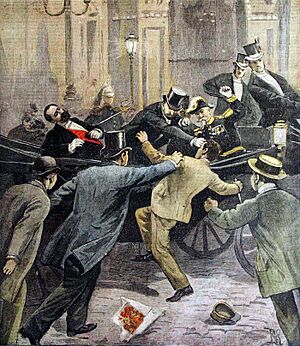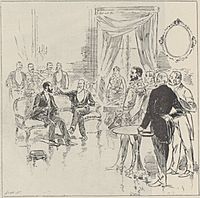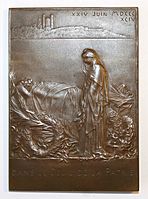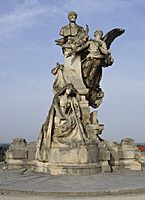Sadi Carnot (statesman) facts for kids
Quick facts for kids
Sadi Carnot
|
|
|---|---|
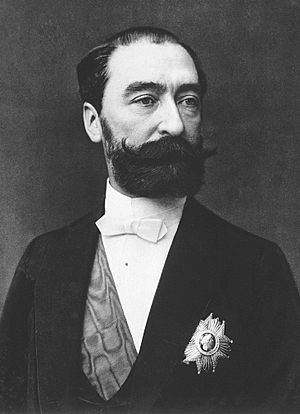
Official portrait c. 1880s
|
|
| President of France | |
| In office 3 December 1887 – 25 June 1894 |
|
| Prime Minister | |
| Preceded by | Jules Grévy |
| Succeeded by | Jean Casimir-Perier |
| Minister of Finance | |
| In office 16 April 1885 – 11 December 1886 |
|
| Prime Minister |
|
| Preceded by | Jean-Jules Clamageran |
| Succeeded by | Albert Dauphin |
| Minister of Public Works | |
| In office 6 April 1885 – 16 April 1885 |
|
| Prime Minister | Henri Brisson |
| Preceded by | David Raynal |
| Succeeded by | Charles Demôle |
| In office 23 September 1880 – 14 November 1881 |
|
| Prime Minister | Jules Ferry |
| Preceded by | Henri Varroy |
| Succeeded by | David Raynal |
| Personal details | |
| Born | 11 August 1837 Limoges, France |
| Died | 25 June 1894 (aged 56) Lyon, France |
| Cause of death | Assassination |
| Political party | Moderate Republican |
Marie François Sadi Carnot (born August 11, 1837 – died June 25, 1894) was an important French leader. He served as the President of France from 1887 until he was sadly killed in 1894.
Contents
Early Life and Education
Sadi Carnot was born in Limoges, France. His father, Hippolyte Carnot, was also a famous statesman. Sadi's third name, Sadi, was given to honor his uncle, Nicolas Léonard Sadi Carnot. This uncle was a brilliant engineer who helped create the rules of how heat and energy work.
Sadi Carnot was a very smart student. He studied to become a civil engineer. He went to two top schools in France: the École Polytechnique and the École Nationale des Ponts et Chaussées. After finishing his studies, he started working for the government.
Early Career in Politics
Because his family believed in a republic (a country led by elected officials), Sadi Carnot was given important jobs. In 1870, he helped organize defenses in several French areas. He became the leader, or prefect, of the Seine-Inférieure region in 1871.
Soon after, he was elected to the French National Assembly. This was like becoming a member of parliament. He joined a group called the Opportunist Republicans. He later became a secretary to the minister of public works in 1878. He then served as Minister of Public Works and Minister of Finance several times between 1880 and 1886.
Becoming President of France
In 1887, France faced some political problems. The previous president, Jules Grévy, had to step down because of scandals. People trusted Sadi Carnot because he was known for being honest. Many important politicians, like Georges Clemenceau, supported him. He was elected President of France with a large number of votes.
He became president during a difficult time. There was a lot of unrest, and a general named Georges Ernest Boulanger was challenging the government. President Carnot helped make the presidency and the republic more popular. He did this by appearing at public events at the right time.
Key Moments as President
In 1889, General Boulanger was forced to leave France. This allowed President Carnot to lead two very important events. One was the celebration of 100 years since the French Revolution. The other was the opening of the Paris Exhibition (a big world fair). Both events were very successful. They showed that the French people supported the republic.
Even though there were often changes in government and some social problems, Carnot faced only one major crisis. This was the Panama scandals in 1892. These scandals damaged the country's reputation. However, people still respected President Carnot because no one could question his honesty.
President Carnot also supported a strong friendship between France and Russia. This was known as the Franco-Russian Alliance. He even received an important award from the Russian Emperor, Alexander III.
His Tragic End
President Carnot was very popular. But on June 24, 1894, something terrible happened. He was giving a speech at a dinner in Lyon. An Italian anarchist named Sante Geronimo Caserio suddenly attacked him with a knife.
Sadi Carnot died early the next day, on June 25. People across France were shocked and very sad. He was given a grand funeral ceremony at the Panthéon in Paris on July 1, 1894.
Caserio said his attack was a political act. He was executed a few weeks later, on August 16, 1894.
Images for kids
-
President Sadi Carnot with Emperor Pedro II of Brazil in Aix-les-Bains, France (Le Monde illustré, 1888).
-
Funeral ceremony at the Panthéon
-
Monumental statue, tribute to Sadi Carnot by Raoul Verlet, in Angoulême, France.
See also
 In Spanish: Marie François Sadi Carnot para niños
In Spanish: Marie François Sadi Carnot para niños
- Carnot - A city in the Central African Republic named in honour of him
- Politics of France
- André César Vermare - Sculptor of statue in Saint-Chamond


